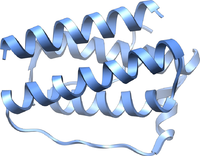
Photo from wikipedia
Simple Summary Pneumonia is a commonly encountered problem in small ruminant medicine practice that negatively affects goat breeding. Some of the limitations of the conventional approaches used by animal breeders… Click to show full abstract
Simple Summary Pneumonia is a commonly encountered problem in small ruminant medicine practice that negatively affects goat breeding. Some of the limitations of the conventional approaches used by animal breeders to promote animal health may be overcome with the use of molecular genetic tools. Using PCR-DNA sequencing in pneumonia-affected and -resistant Baladi goats, SNPs associated with pneumonia resistance/susceptibility were found in the SLC11A1, CD-14, CCL2, TLR1, TLR7, TLR8, TLR9, β defensin, SP110, SPP1, BP1, A2M, ADORA3, CARD15, IRF3, and SCART1 genes. These indicators’ mRNA levels were different in both the healthy and affected goats. Therefore, to improve the effectiveness of animal selection for innate resistance, finding potential genes linked to pneumonia risk may be crucial. Abstract The effectiveness of breeding for inherent disease resistance in animals could be considerably increased by identifying the genes and mutations that cause diversity in disease resistance. One hundred and twenty adult female Baladi goats (sixty pneumonic and sixty apparently healthy) were used in this study. DNA and RNA were extracted from blood samples collected from the jugular vein of each goat. SLC11A1, CD-14, CCL2, TLR1, TLR7, TLR8, TLR9, β defensin, SP110, SPP1, BP1, A2M, ADORA3, CARD15, IRF3, and SCART1 SNPs that have been previously found to be associated with pneumonia resistance/susceptibility were identified via PCR-DNA sequencing. The pneumonic and healthy goats differed significantly, according to a Chi-square analysis of the discovered SNPs. The mRNA levels of the studied immune markers were noticeably greater in the pneumonic goats than in the healthy ones. The findings could support the significance of the use of immune gene expression profiles and nucleotide variations as biomarkers for the susceptibility/resistance to pneumonia and provide a practical management technique for Baladi goats. These results also suggest a potential strategy for lowering pneumonia in goats by employing genetic markers linked to an animal’s ability to fend off infection in selective breeding.
Journal Title: Veterinary Sciences
Year Published: 2023
Link to full text (if available)
Share on Social Media: Sign Up to like & get
recommendations!